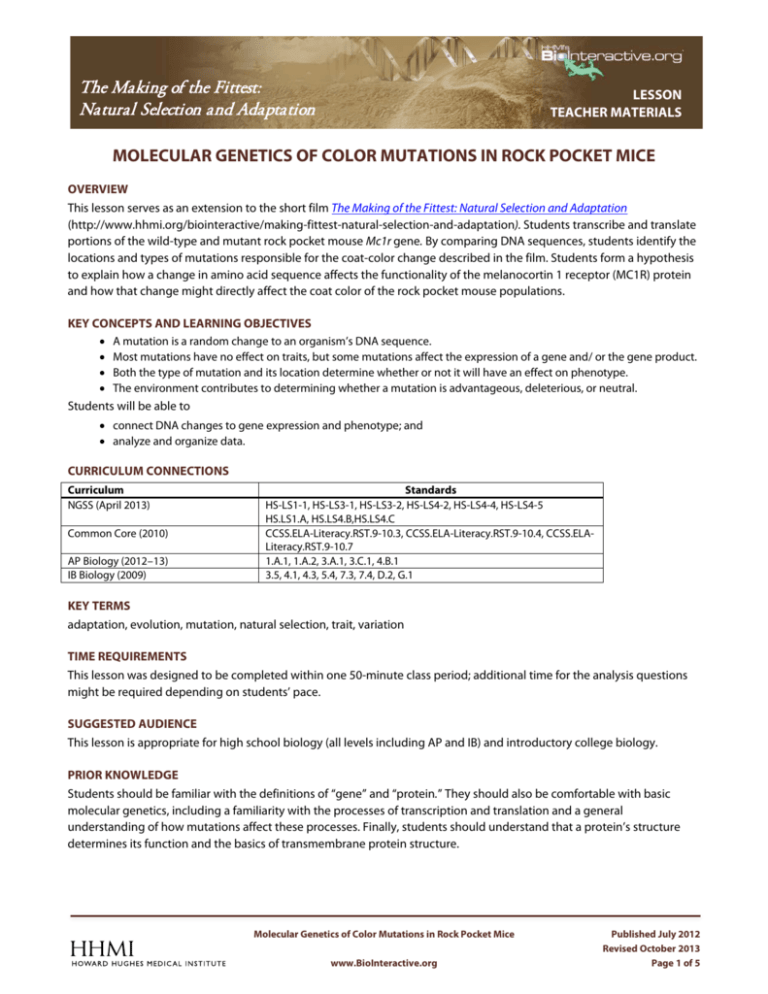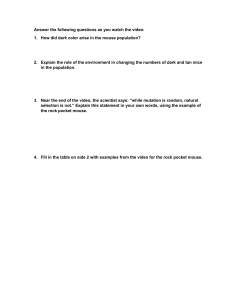
Volcanic rocks that formed from cooling lava flows are found, separated by several kilometers of light- colored substrate.

Most of the landscape consists of light-colored sand and rock, but patches of dark Materials, that make up the desert floor. There are also two major colors of substrate, or surface There are twoĬommon varieties-a light-colored variety and a dark-colored variety. You can find populations of rock pocket mice all over the Sonoran Desert in the southwestern United States. Rock pocket mice, however, have had an enormous Grams, this tiny mouse weighs about as much as a handful of paper clips. eLife, 4, e06813.Name _ĬOLOR VARIATION OVER TIME IN ROCK POCKET MOUSE POPULATIONSĪ typical rock pocket mouse is about 170 millimeters long from nose to rump, shorter than an average pencil. The natural history of model organisms: Peromyscus mice as a model for studying natural variation.
#Rock pocket mouse worksheet series#
Molecular, and heredity levels-using a series of online interactive lessons. The ConnectedBio curriculum helps students create a network of connectedīiological concepts spanning multiple scales-from the population, organism, Learn more about the Connected Biology project. Please take our five-question teacher survey if you use this activity Try more levels of the ConnectedBio MLS at /lm0. To test this, use the hawks on the beach environment until all the mice have light fur, then compare with "Mutation" on vs. Such variation in offspring allows species to adapt to changes in the environment. Remind students that offspring are not duplicates of their parents there is natural variation. Wrap up with a discussion about the fur color changing in the population over time.

This worksheet can support student data collection: /lm5. To compare any changes quantitatively, have students record their data from three trials of each experiment. Compare the fluctuations in fur colors to the changes when hawks were present. Invite students to start over without hawks, tracking the data with the graph. Instead, help students investigate their ideas. Some students think that individual mice protect themselves by rolling in the dirt on fields, or that fur becomes bleached in the sun. This observation can elicit the alternate conceptions above, and it is important to get them out in the open at this stage. Over 5 to 10 simulated years, the population's fur color changes to match the environment (Figure 2). This is another way to focus on the population and help students to see the passing of generations.ĭoes the fur color of the population change over time when hawks are present? Students should notice the frequent mouse births and deaths, evidence of the many generations of mice, which is critical for recognizing that the fur color of the population changes.ĭeer mice live about 2 or 3 years (both in the simulation and in the wild). Use the following questions to stimulate explorations and observations:

The ConnectedBio Multi-Level Simulation (MLS) allows students to explore how each biological level of scale contributes to the evolution of fur colors in the deer mouse.ĭeer mice live in many different habitats across North America.In each subpopulation, their fur coloring is a good match to their habitat (Figure 1). Admittedly, this is a big job as there are several mechanisms at multiple levels: adaptation occurs at the population level while survival occurs at the organism level, and traits (which can help survival) are generated at the molecular and cellular level. To understand adaptation in response to natural selection, students have to refocus their attention. But because they are focused at the organism level instead of the population level, they overlook the actual mechanisms for natural selection. It's not uncommon for new biology students to talk about individual organisms “adapting to their surroundings.” They are invoking the idea that there is a need to change. "The mouse's fur color changes, so it won't be seen and eaten by the hawk." "The mice can survive by blending into their environment."

Population level of the ConnectedBio Multi-Level Simulation.


 0 kommentar(er)
0 kommentar(er)
